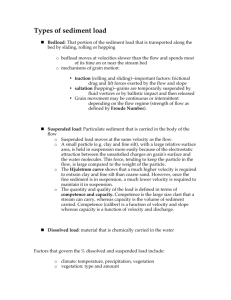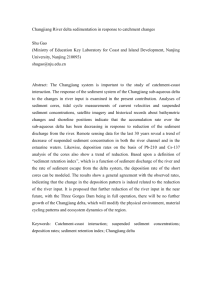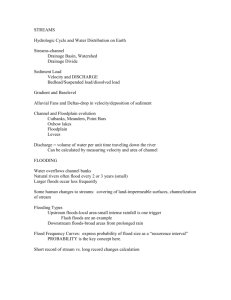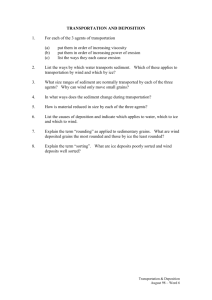Deposition - Coolgeography.co.uk
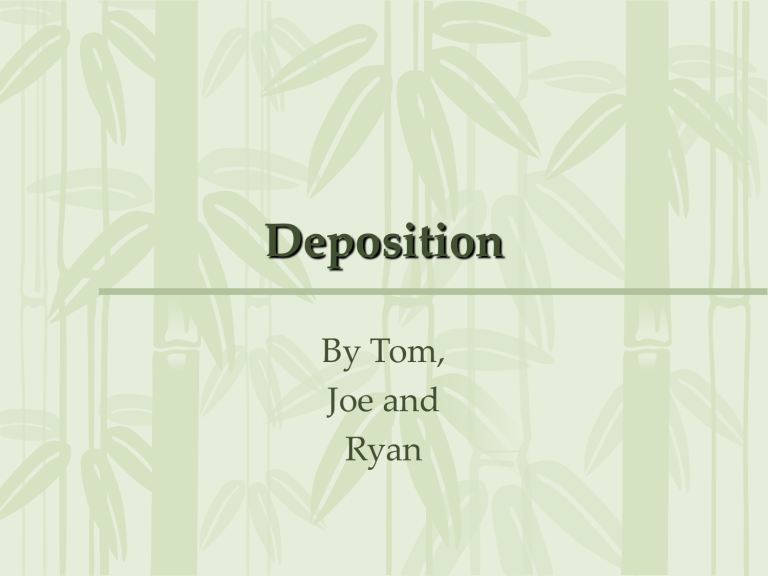
Deposition
By Tom,
Joe and
Ryan
Deposition
• Deposition is the release of the particles that a river is carry due to a decrease in the velocity of the river.
• The Hjülstrom Curve shows the relationship between the velocity of the river and the size of particles that the river will deposit, transport or erode. It shows that the river begins to deposit boulders first, then gradually deposits smaller particles as the rivers velocity decreases. Ending with the deposition of particles any less than
0.01mm at 0.1cm/s.
Deltas
• A delta forms when the rivers velocity drops due to it entering a slower moving body of water. As the river begins to slow down it deposits the largest of the transported particles first, then as the velocity decreases ever more the size of the particles that the river deposits slowly gets smaller. Therefore the large sediment is found at the front of the delta with the sediment size decreasing as the delta nears the sea. Deltas are normally triangular in shape and there are two types;
Arcuate and Bird-foot.
• Distributaries are also form part of delta formation.
These occur when the river splits and becomes more than one individual river. A good example of this is the
Mississippi delta, a picture of this is shown on the following slide
Deltas; Flocculation
• Flocculation refers to a process by which a solute comes out of a solution. As the
sediment is dropped the charged particles, such as clays and polymers, clumps together to form flocs.
An arcuate delta that has formed on the south-west coastline of Greenland, near
Narsarsuaq.
A close up image of the currently active Mississippi delta, which is a bird-foot delta.
Change in the Mississippi Delta
Braided river
•A braided river is a channel that consists of a network of
smaller channels separated by small and often temporary islands called braid bars. However some braid bars become that stable that they become almost permanent, with some having settlements on them. Braided streams are common wherever a drastic reduction in velocity causes the rapid deposition of the stream's sediment load. Braided channels are also common in river deltas.
•The channels and braid bars frequently move, with the river layout often changing significantly during flood events.
Channels move sideways via differential velocity: On the outside of a curve, deeper, swift water picks up sediment
(usually gravel or larger stones), which is re-deposited in
slow-moving water on the inside of a bend.
Levees
• The ability of a river to carry sediments is dependent on it velocity. When a river floods over its banks, the water spreads out, drops in velocity , and deposits its load of sediment. Over time, the river's banks are built up above the level of the rest of the floodplain. The resulting ridges are called natural levees. The sediment that is left on the floodplain is known as alluvium.
• When the river is not in flood it may deposit material within its channel, raising its level. The combination can raise not just the surface, but even the bottom of the river above the surrounding country. Natural levees are especially noted on the Yellow River in China near the sea where ocean-going ships appear to sail high above the plain on the elevated river. Natural levees are a common feature of all meandering rivers in the world.
The largest sediment will be deposited closest to the bank because the larger sediment requires the greater velocity.
As the velocity decreases as the river floods, the sediment will decrease in size as the distance from the river increases.
Levees
Flood Plains
• A floodplain is flat or nearly flat land
adjacent to a stream or river that experiences
occasional flooding.
Floodplains are formed by the deposition of sediment carried by river as it floods.
Flood Plains
• As the river continuously floods, the sediment that is deposited accumulates in depth and therefore as the depth of the sediment increases, the age of the sediment at the base of sediment will increase.
• Also the river will constantly change its course, this will cause lateral erosion of the banks of the valley. This means that the width of valley will increase over geological time.
Bibliography
• http://www.web.umr.edu/~rogersda/levee s/Should%20I%20Tru...
• http://www.wikipedia.org.
• http://www.google.ca
• http://www.internal.eawag.ch/~uehlinge/
Pictures.html
